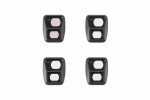- Joined
- Nov 12, 2019
- Messages
- 893
- Reactions
- 1,075
- Age
- 67
I'm not a photographer, so can all of you explain the ND filters please? Mine will arrive next week.
Since there are two cameras, do the top and bottom filters match density (both ND 8 for example) or should there be a difference in density between the upper and lower camera?
Since there are two cameras, do the top and bottom filters match density (both ND 8 for example) or should there be a difference in density between the upper and lower camera?










